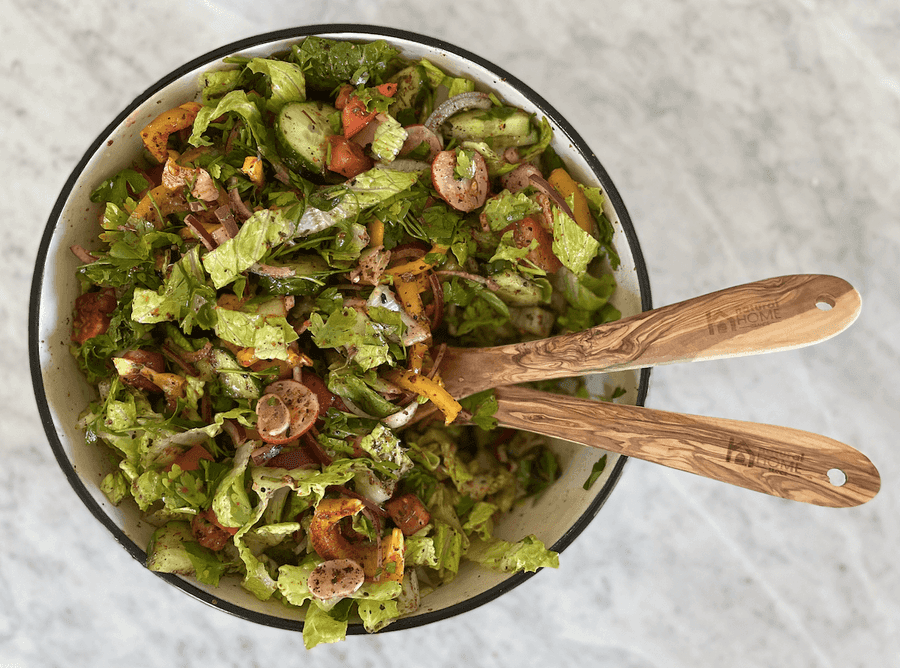Feed Your Gut with Fattoush
by Amylee Amos PhD, RDN, IFMCPRecipes
100 trillion friends that you didn’t know you had are living inside your body as you read this. These gut microbes are as essential to your health as are your own human cells. Fortunately, talking about gut health is far more mainstream than it used to be. The research on the gut microbiome and its impact on human health is monumental and irrefutable. We know without a doubt that a healthy gut promotes health and that an unhealthy or imbalanced gut promotes disease. Yet we still partake in behaviors and largely live in an environment that inhibits the growth and proliferation of these healthy gut microbes.
The good news is that the fate of our gut bugs lies at the end of our fork. Diet is the most actionable treatment modality and also has the most powerful impact on the gut microbial communities. But that impact can be positive or negative. Research shows that about 75% of the western diet is of limited or no benefit to the bacterial communities in the gut (1). Our standard American diet does not contain the fiber, vitamins, minerals, or phytonutrients needed to support healthy gut flora. And as this westernized, standard American diet slowly infiltrates throughout the world, so does chronic disease.
The impact of diet on the microbiome is powerful and fast. Studies of diet changes have found that within 1-2 days of changing the diet, major alterations are visible in the microbiome (2). Diets high in vegetables and fruits are associated with bacterial richness, meaning dense populations of healthy bacterial strains. And unlike taking a probiotic supplement in which the bacteria act more like tourists in the gut, the gut microbial environment can be permanently changed by permanently changing the diet (3).
So we need a diet rich in plant species. We need both quantity and variety of vegetables and plants in order to optimize our gut microbial composition. That means we can’t eat a westernized or standard American diet. Luckily, the diets of other cultures are rich in vegetables, and spices, and herbs that the gut needs. That’s why we have featured Fattoush. This Syrian salad is loaded with prebiotic fiber from radishes, onions, and tomatoes. It has leafy greens from lettuce, parsley, and purslane. It incorporates antioxidant rich mint, pomegranate, Aleppo pepper, cumin, and sumac. Overall, it is the incredible food that your microbes need to keep you well.
Another bonus to eating all of these fiber-rich vegetables is that it leads to the production of butyrate, the fuel source of the cells in the large intestine (4). Adequate buyrate is associated with overall colon health, but also increases neurotrophic factors like brain derived neurotrophic factor (BDNF) and nerve growth factor- further support that maintaining the health of our gut in turn maintains the health of our brain.
Ingredients:
- 1 head lettuce, chopped
- 1 large bunch parsley, chopped
- 1 bunch purslane
- 1 medium onion, diced
- 1 bunch green onions, diced
- 1 bunch radishes, chopped
- 3 medium tomatoes, chopped
- 4 persian cucumbers, slices
- 5-6 fresh mint leaves
- 1 tablespoon cumin
- ½ tablespoon Aleppo pepper
- ½ tablespoon dried thyme
- ½ tablespoon dried oregano
- ½ tablespoon sumac
- ¼ cup extra virgin olive oil
- ⅛ cup pomegranate molasses or pomegranate juice
- 2 tablespoons fresh lemon juice
- Salt to taste
Directions:
- Assemble all ingredients into a large bowl.
- Toss well and serve.
References:
1. Bengmark, S. “Nutrition of the Critically Ill: a 21st century perspective.” Nutrients 2013, 5, 162-207.
2. David LA, Maurice CF, Carmody RN, et al. Diet rapidly and reproducibly alters the human gut microbiome. Nature. 2014;505(7484):559-563.
3. Cotillard A, Kennedy SP, Kong LC, et al. Dietary intervention impact on gut microbial gene richness. Nature. 2013;500(7464):585-588.
4. Bourassa MW, Alim I, Bultman SJ, Ratan RR. Butyrate, Neuroepigenetics and the Gut Microbiome: Can a High Fiber Diet Improve Brain Health? Neuroscience letters.2016;625:56-63.